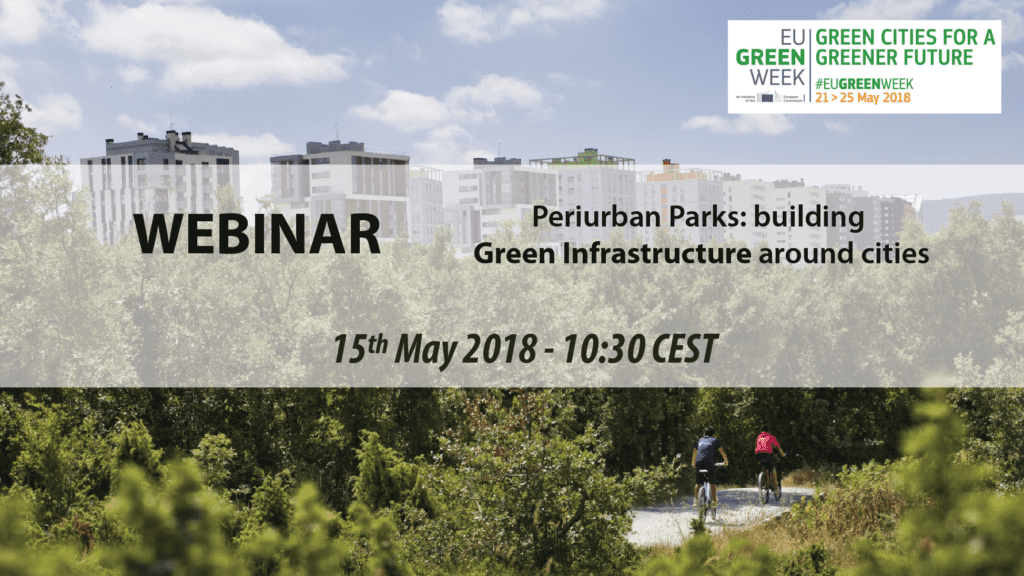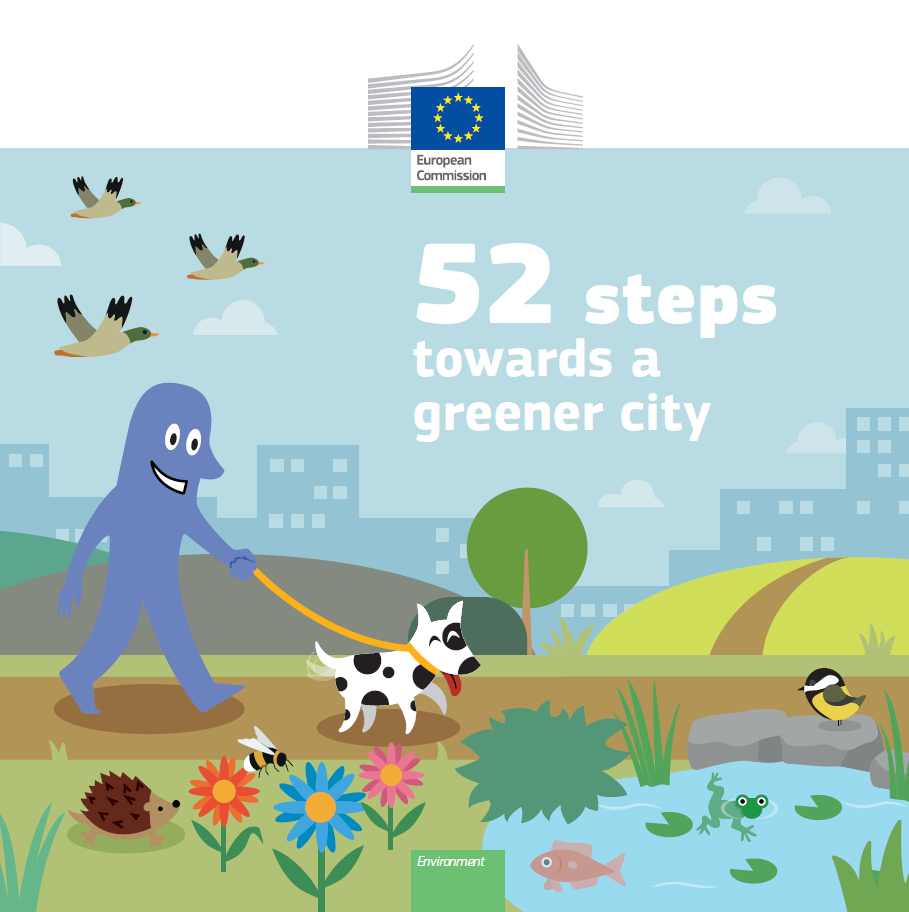A EUROPARC Youth Manifesto
Youth gathered in Scotland, first meeting of EUROPARC Youth Manifesto © Alan Smith
Youth taking the Lead for Nature – Shaping Protected Areas & Rural Communities!
This May, youth from across seven countries gathered in Cairngorms National Park to kick-off the process of writing up a “EUROPARC Youth Manifesto”
The final Youth Manifesto will point out the challenges of young people living, learning and working in Rural Communities and Protected Areas, but also offer straightforward solutions how to address those issues at regional and local levels. The results are meant to serve as a source of inspiration for concrete action by decision-makers, public authorities and managers:
- How to design sustainable living spaces not only for, but together with the young generation?
- How to involve and empower young people in decision-making?
- How to encourage young people to retain in or move to rural and protected areas?
- …all this ensuring environmental stewardship and creating more dynamic and future-oriented communities.
Throughout two workshops weeks this May and June the young project participants, aged 16-25, tackle those questions.
EUROPARC Youth Manifesto: What happened so far?
The first workshop ran from 21st to 25th May, during what must have been one of the hottest weeks Cairngorms National Park has experienced in a while. Nonetheless participants arrived ready to work hard and curious to learn about the stories of their peers. The week was all about experience sharing, ideating and drafting the Manifesto. In short presentations throughout the week everyone shared some interesting, informative, inspiring or funny aspects of their own life.
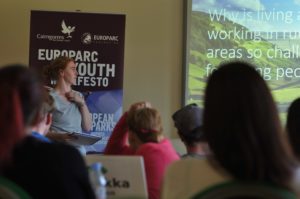
“Why is living and working in rural and protected areas so challenging for young people?” ©Konatsu Hagita
In small groups, participants then worked on identifying challenges and coming up with solutions focused on three guiding topics: “living”, “learning” and “working” in protected areas and rural communities across Europe.
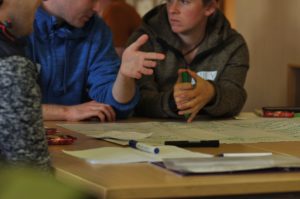
Group works allowed for some focused discussion on ways to. ©Konatsu Hagita
Working groups came up with some very concrete ideas how to support young people in building a good life in rural and protected areas. Besides the clear message to improve infrastructure allowing youngsters to be more connected via transport and social media, the value of engaging young people in outdoor activities, in nature conservation and in living their cultural crafts and traditions were big topics discussed among participants
All the thinking work required some active balance away from the desks – and besides the activities organized by the hosts, participants were quite happy to take care of the fun part themselves.
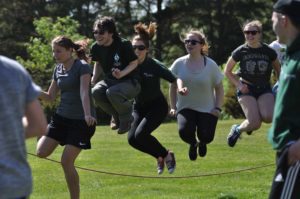
The young people shared not only thoughts but also spent their breaks exchanging outdoor games. With “Finnish Twister” – of which photos remain unpublished – turning out as one of the highlights. ©Konatsu Hagita
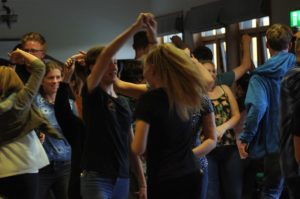
Participants getting a feel for Scottish culture. A local “Feis” band came to play and made everyone try some traditional dances. ©Konatsu Hagita
After a week of dedicated work – and good fun too – a first Manifesto draft was achieved. The key message of the young people is clear:
We are the future yet under-represented in any decisive board; but we are capable and willing to give input and implement changes if given the chance.
Now, what is next?
This June, 17th to 21st, participants will meet again in Kalajoki, Finland for the second project workshop. Youth representatives, who were already part of the drafting group will mix up with some new faces – bringing in some fresh perspectives when finalizing the Manifesto. Besides, youngsters will join workshops about youth involvement in governance and policy-making – a starting point to become an active ambassador of youth interests and the Manifesto back home.
The youngsters will launch the final Manifesto during the EUROPARC Conference 2018 in Cairngorms National Park. They will share their work in a public presentation and be around to talk to you in person about their ideas.
Make sure you don’t miss out: Sign up for the conference here. There is a special youth rate available for people younger than 30 – and until 2nd July the Early Bird fees still apply.
Meanwhile…
Read more on the first Manifesto workshop week in Cairngorms National Park in this article by the Cairngorms LEADER Local Action Group.
Feel free to follow the EUROPARC Youth Manifesto work in progress via Facebook, Twitter or Instagram (@europarc.youthplus).
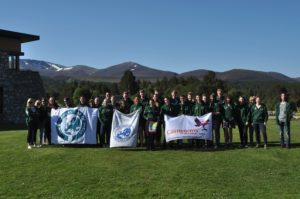
25th of May – Participants sending out greetings to their Protected Areas on European Day of Parks 2018 ©Konatsu Hagita
_______________________________________________________
Who runs the project?
The EUROPARC Youth Manifesto is created as an output of a transnational LEADER project, led by the Cairngorms National Park Authority in collaboration with three Finnish LEADER groups Rieska, Keskipiste, and Ravakka; the Cairngorms Local Action Group; Scottish Natural Heritage; Young Scot and EUROPARC Federation. The project supports the Scottish Year of Young People 2018.
“Green cities do better” – EUROPARC at EU Green Week 2018
EU Green Week 2018 © European Commission DG Environment
Last week was a special week for all Protected Areas in Europe. Starting with the celebration of the Natura 2000 Day that matched the opening of the EU Green Week 2018, the Natura 2000 Awards Ceremony, and closing with the celebration of the European Day of Parks! This meant also a very intensive week for EUROPARC network, especially in our Brussels office. Below, the main highlights of the Green Week for Parks across Europe.
“Green cities do better”
was the message of the EU Green Week 2018, that a took place from 21 to 25 May 2018, with the objective this year of drawing attention to the benefits of bringing nature into our cities. This year, the kick-off took place in Utrecht, Netherlands on the 21st May: the Natura 2000 Day. There, the European Commissioner for the Environment, Karmenu Vella, together with local and national representatives, and the Executive Director of the United Nation’s Environment Program, officially launched the Week.
Building a city that is genuinely sustainable and ‘fit for the future’ takes vision, a long-term perspective, and investment
The role of Periurban Parks
As now the official representative network of Periurban Parks, following last years’ integration of FEDENATUR into EUROPARC, we organised a special webinar dedicated to the role of Protected Areas building Green infrastructure in and around cities. The webinar was organised by the members of the EUROPARC Periurban Commission and two case studies reflecting different geographical realities were presented: the green ring of Victoria-Gasteiz and the Green Strategy of the Barcelona Metropolitan Area.
“Nature in the City” Workshop
On the 23rd May, EUROPARC supported the organisation of the workshop in Brussels “Nature in the city“, where we looked from different perspectives on how nature-based solutions and green infrastructure can provides solutions for urban challenges and increase citizens’ quality, health & social life. Our invited speaker, Wilma Zijlema, Post-Doctoral Researcher at the ISGlobal, Barcelona Institute for Global Health, presented the case study of Collserola Nature Park in the outskirts of Barcelona, and the importance it has to the livelihoods of its citizens.
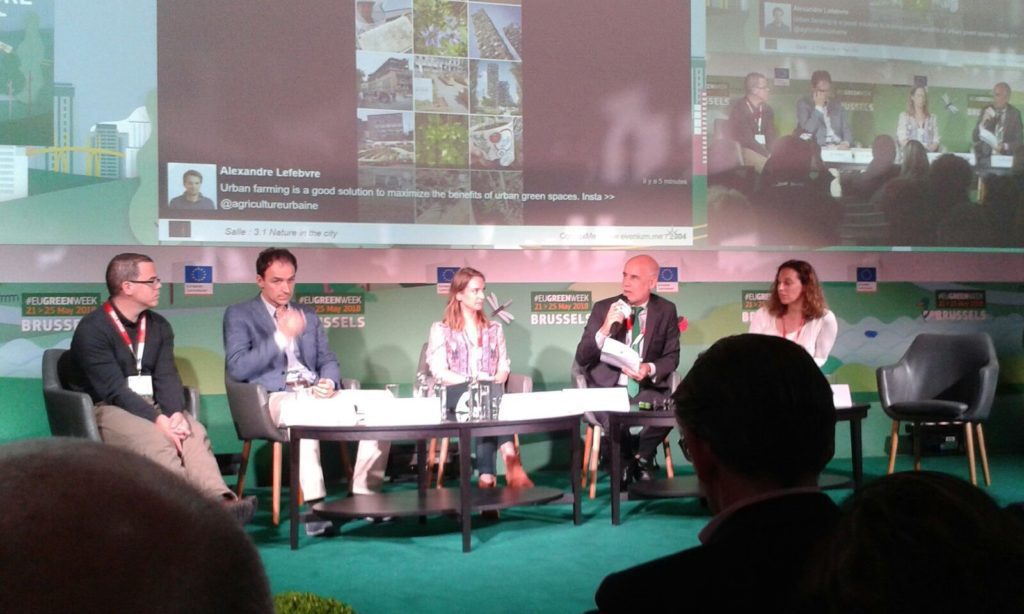
Workshop Nature in the city – EU Green week 2018 © European Commission
The presentations are available for download here. The session was moderated by Humberto Delgado Rosa, Director for Natural Capital at the Directorate-General for Environment, European Commission; and other perspectives were shared by Nick Paling, Head of Data, Evidence & Communications, Westcountry Rivers Trust (UK); Dr Davide Geneletti, Associate Professor, Planning & Design for Sustainable Places Lab, DICAM – University of Trento (Italy); Gitty Korsuize, Consultant, Green Areas & Urban Nature (The Netherlands); and Patrick ten Brink, Director for EU Policy, European Environmental Bureau.
“52 steps towards a greener city”
A green city depends not only on land planning cabinets and governmental organizations. There is a wide range of actions that can be done by each citizen, towards having a more environmental-friendly lifestyle in the city. That is why the European Commission launched the guide “52 steps towards a greener city” available for download in all members’ languages.
During the week there was also another celebration day: the European Day of Parks, 24th May, where EUROPARC and IUCN organized a Webinar about “Solutions from European Protected Areas“ to promote examples of successful approaches from 2 different regions in Europe.
EU Large Carnivore Platform Meeting: Comparing good practice across the EU
The fifth annual meeting of the EU Platform on Coexistence between People and Large Carnivores took place yesterday in Brussels. The Platform brings together representatives from landowning, herding, hunting, research and conservation organisations to “promote ways and means to minimize and find solutions to conflicts between people and large carnivores”. The Plenary meeting is the annual opportunity for the Platform members to review their work plan and agree the next years’ work.
EU Large Carnivore Platform Plenary Meeting: Comparing good practice across the EU
The agenda started with a situation review, examining large carnivore status across the EU. The IUCN Species Specialist Group – the Large Carnivore Initiative for Europe (LCIE) has carried out a major information gathering exercise to bring together and analyse the information on large carnivore numbers, ranges, damages and threats to conservation. An early version of the results was presented to the Platform members, full results will be ready published later this year. Linked to this item, the Platform reviewed how protection measures are being implemented in the EU and how member states fund such measures through national or European funding.
The work of national and regional large carnivore platforms and how the EU Platform can support, exchange with, and learn from them were also discussed. A final item on the agenda was a review of information on fear and risk associated with large carnivores. The Platform discussed good practices for addressing the fear of large carnivores.
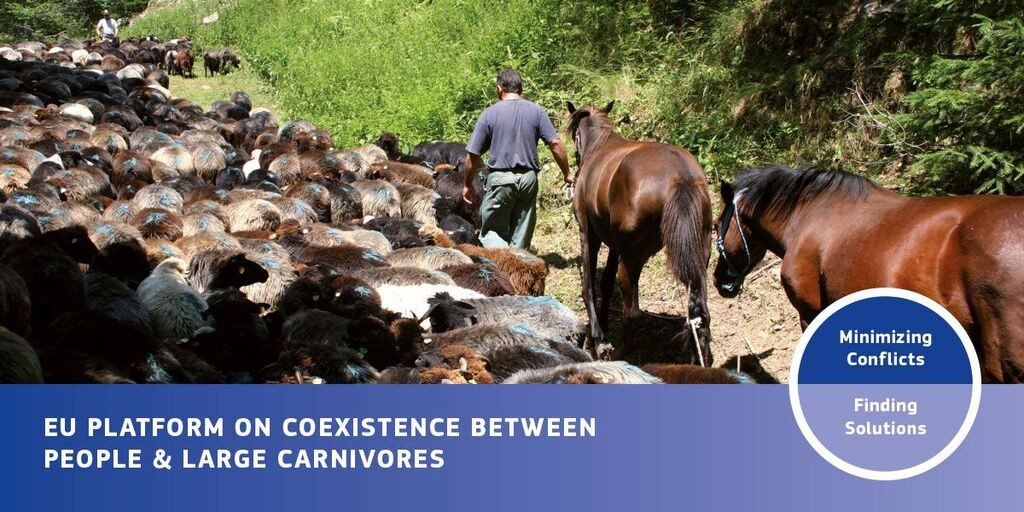
Humberto Delgado-Rosa, Director for Natural Capital, DG Environment, who co-chairs the meeting for the European Commission, said:
The focus of this group on coexistence is very important. The Platform supports constructive dialogue without neglecting socio-economic impacts. We understand well that there is real hardship associated with the presence of large carnivores, particularly for livestock managers in some locations, and targeted support is needed. With the establishment of regional platforms in different member states, the role of the EU Platform to link these initiatives in conflict areas becomes increasingly important.
Thierry de l’Escaille, Secretary General of the European Landowners Organization and co-chair of the Platform said: “The Platform provides a useful forum for bringing together a range of different interests to discuss some of the issues surrounding coexistence with large carnivores. Useful discussions have taken place on a number of conflict issues, such as how to finance protection measures for livestock and beekeepers and also the increasingly important issue of fear of large carnivores. We hope that by providing balanced, impartial information on these issues, we can promote constructive dialogue between different interest groups.”
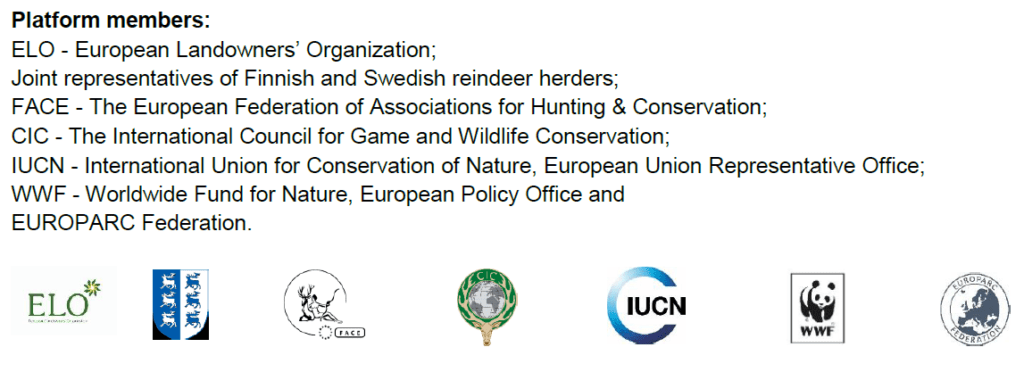
To learn more about the platform on the Coexistence between people and large carnivores please visit the platform website.
Participatory planning of sustainable tourism in Protected Areas
The Interreg CEETO project (Central Europe Eco-Tourism) entered the implementation phase with the workshop on participatory planning of sustainable tourism in Protected Areas and its work at local on the 8 pilot areas. The meeting will take place in Austria, on the 4-5 June.
Management bodies of Protected Areas partners will be supported in the participatory planning process to define the local Sustainable Tourism Action Plan, supplying them with guidelines and methodological tools. For example, the Capacity Building Workplan will allow the managers of each Protected Area to define their own tailored participatory planning process, according to their specific context, level of local stakeholder involvement and tourism monitoring needs and priorities.
It will also be discussed the correct approach towards participatory planning and how to carry out a correct assessment before starting the implementation of the process in the framework of CEETO Project; and how to design an incisive, effective and time-saving participatory planning process.
Participatory Mapping will be used to define the most precious/valuable areas to preserve and promote in the Protected Area, the most vulnerable areas endangered by tourism pressure, the most relevant tourism flows that cross the Protected Area.
During the Workshop will be tested the World Cafe methodology designed to create a collaborative environment to develop concrete actions and initiatives from multiple ideas coming from different stakeholders. In fact, World Cafe combines interactions between stakeholders and multiple focus group on different thematics and topics. So that scientific, technical and community knowledge are committed to the same goal.
More info and regular udates on : https://www.interreg-central.eu/CEETO

